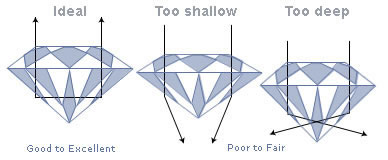Diamond clarity
|
Diamond clarity Clarity is a measure of internal defects of a diamond called inclusions. Inclusions may be crystals of a foreign material or another diamond crystal, or structural imperfections such as tiny cracks that can appear whitish or cloudy. The number, size, colour, relative location, orientation, and visibility of inclusions can all affect the relative clarity of a diamond. The Gemological Institute of America (GIA) developed systems to grade clarity, which are based on those inclusions which are visible to a trained professional when a diamond is viewed under 10x magnification. The Clarity of your diamond is graded using this scale:
Polish and symmetry are two important aspects of the cut. The polish describes the smoothness of the diamond's facets, With poor polish, the surface of a facet can be dulled, and may create blurred or dulled sparkle. It may constantly look like it needs to be cleaned. The symmetry refers to alignment of the facets, with poor symmetry, light can be misdirected as it enters and exits the diamond. It is the Cut and symmetry of your diamond that determines how light is bounced from facet to facet, resulting in the wonderful sparkle diamonds are so loved for.
The techniques for cutting diamonds have been developed over hundreds of years, with perhaps the greatest achievements made in 1919 by mathematician and gem enthusiast Marcel Tolkowsky. He developed the round brilliant cut by calculating the ideal shape to return and scatter light when a diamond is viewed from above. The modern round brilliant has 57 facets (polished faces), counting 33 on the crown (the top half), and 24 on the pavilion (the lower half). The girdle is the thin middle part. The function of the crown is to diffuse light into various colors and the pavilion's function to reflect light back through the top of the diamond. |
Flawless category (FL) Diamonds have no inclusions or blemishes visible under 10x magnification. Internally Flawless category (IF) Diamonds have no inclusions visible under 10x magnification, only small blemishes on the diamond surface. Very, Very Slightly Included category (VVS) Diamonds have minute inclusions that are difficult for a skilled grader to see under 10x magnification. The VVS category is divided into two grades; VVS1 denotes a higher clarity grade than VVS2. Pinpoints and needles set the grade at VVS. Very Slightly Included category (VS) Diamonds have minor inclusions that are difficult to somewhat easy for a trained grader to see when viewed under 10x magnification. The VS category is divided into two grades; VS1 denotes a higher clarity grade than VS2. Typically the inclusions in VS diamonds are invisible without magnification, however infrequently some VS2 inclusions may still be visible to the eye. An example would be on a large emerald cut diamond which has a small inclusion under the corner of the table. Slightly Included category (SI) Diamonds have noticeable inclusions that are easy to very easy for a trained grader to see when viewed under 10x magnification. The SI category is divided into two grades; SI1 denotes a higher clarity grade than SI2. These may or may not be noticeable to the naked eye. Included category (I) Diamonds have obvious inclusions that are clearly visible to a trained grader under 10x magnification. Included diamonds have inclusions that are usually visible without magnification or have inclusions that threaten the durability of the stone. The Included category is divided into three grades: I1. denotes a higher clarity grade than I2, which in turn is higher than I3. Inclusions in I1 diamonds are often seen to the unaided eye. I2 inclusions are easily seen, while I3 diamonds have large and extremely easy to see inclusions that typically impact the brilliance of the diamond, as well as having inclusions that are often likely to threaten the structure of the diamond.) This category is also known as 'piquet' (P1, P2, P3) which is French for 'mark' or 'blemish'. |


